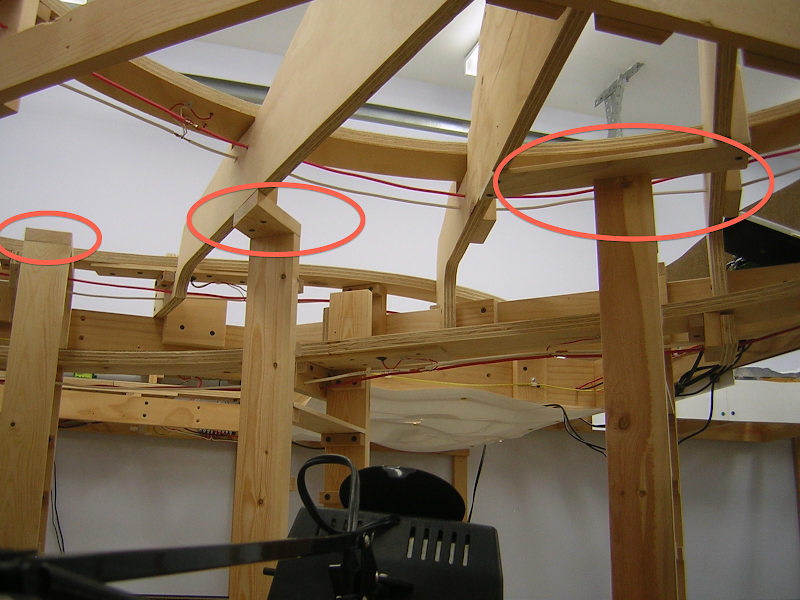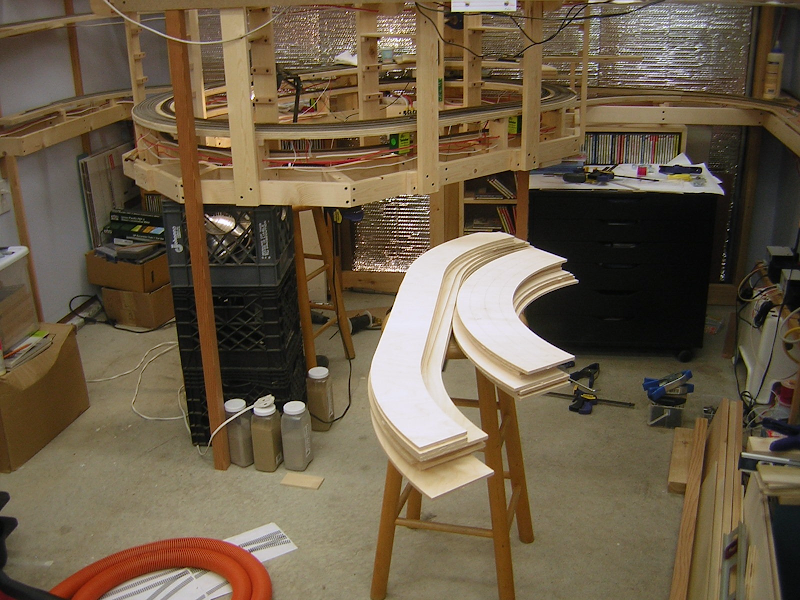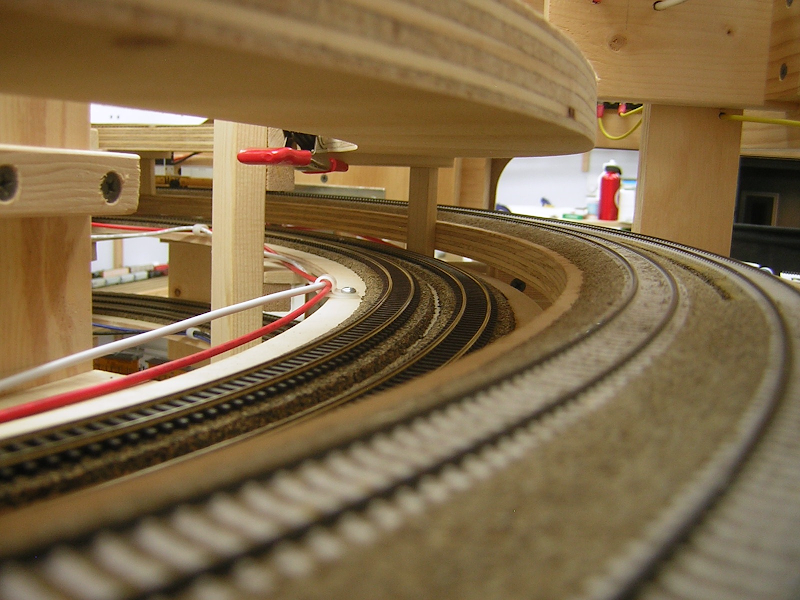2015 - The Year of the Vortex.Brace yourselves for a novella here. There is a reason I haven't posted much in the last several months, and it's not because I haven't been working on the layout, but rather because all of the pictures would have looked hideous, like this:

(the Vortex under consruction, with every tool and supply in the arsenal strewn about), or this:

(the "shoo-fly" that used to close the upper deck; without it, running trains has been severely hampered). Rewind to the beginning of 2015, when I had made the supporting benchwork for the Vortex and had started the second loop:

This is a good time to remind you that the Vortex serves many functions, and is the result of trying to stuff 10 pounds of sh#t into a 5 pound bag. Its main function is a helix that serves as south staging (Mojave), but it also has two independent mainline loops that run concentrically outside the main helix (the combination is called the Vortex). The loop pictured above contains one inner track -- the bottom of Mojave staging -- and a double-track outer loop that connects Bakersfield -- north staging -- to Edison, the first town on the way to the pass. Because this mainline section will remain visible I wanted to ballast & weather it like the rest of the mainline before I built more helix turns over it. Given that this segment comprises ~20 feet of mainline (times 2 tracks) and that my pace for ballasting & weathering is about 3 hours per foot, you can do the math and see how many hobby hours went into finishing this loop… Here are a few shots taken when that was done:

The front side of the loop has a #10 mainline crossover (roughly corresponding to Magundon the prototype), while the back side has "Control Point Charlie":

a crossover that connects
east (Mojave staging) to
west (the main line to Bakersfield). This crossover will only be used for continuous running and/or re-staging.
Up to this point the roadbed could be supported with simple risers, but the remaining loops would require more conventional helix supports. I settled on a design that employed pairs of 1x3 risers with 1x1 cleats for supporting cross-members (see above). One of the challenges was figuring out how to secure the tops of the 1x3's to the pre-existing Loop benchwork above. Each one required a different solution; here are some examples:

One of the best decisions I made in this build was to have the remaining loops of roadbed cut from 1/4" Baltic birch plywood on a CNC router. I was able to make a simple line drawing in xtrakcad, export it to pdf, email it to a local maker shop, and pick up the parts a few days later:


And they all fit perfectly! The next few loops went pretty swiftly, though there was plenty of crawling into and out of the helix, and crouching while inside of it - quite taxing on an aging body! Here is a shot midway up the climb:

In the background you can see freshly glued track being weighted down while in the foreground I am soldering two sections of Peco flex together and adding feeders to them. What fun it was to snake semi-rigid 6-foot sections of track into the helix without breaking off the feeders, but I was determined to have all curved track joints be pre-soldered. The results are worth it though.
At this point we are into June and I was still on track to get the helix operational in time for a few practice ops sessions so I could host a session or two in "Vanrail 2015", our semi-annual invitational ops event taking place next month. Sadly it was about this time that I learned that my father's 8 year battle with melanoma had entered stage IV and I had to leave for California immediately to place him into hospice care. For better or worse, dad died less than a week later, on June 28 and I have spent most of the last month in California helping my brother take care of his affairs, so my plans to host a Vanrail session this year have evaporated.
Fast forward to August and the Vortex is now operational. Here are some detail shots:

This shows the construction with the Baltic birch roadbed: the rise is 3 1/4" per turn (2.0%) and the finger clearance is 3" which is enough to rectify derailments. The lower 3 turns are triple track:

The two inner tracks can stage 2 long northbound (originating) trains each while the outer track holds southbound (terminating) trains. The two upper loops are double track to clear the pre-existing mainline loop that connects the lower deck mainline (still to be constructed) with the upper deck, the ballasted track in this shot:

The double track portion of the helix can stage two more northbound trains for a total of 6.
Here is an arial view showing how the top of the helix connects to the upper deck mainline: the tracks at the far left connect to the helix just below the edge of the photo, and to the east slope main along the top of the photo:

The section on the left is separated from the Loop scene by a photo backdrop so as to not detract from it. Next is a bird's-eye view of the helix:

This gives a good depiction of how I pictured it in my head when I was planning the layout (with staging stacked under the Loop). It's really gratifying to see it in 3-d now!
Here is the view of the terminal manager's "pit" where staging will be managed:

and the view from in the pit:

Here is the Bakersfield-Edison mainline taking one turn in the Vortex to gain elevation:

The track on the far left connects Bakerfield staging with the storage yard below. Ballasting track is the only real "modeling" I have done in the past year, but I do rather enjoy it:


On the other side of the Vortex you can see the two connections to the storage yard:

The foreground track connects to the bottom of the staging helix while the background track connects to Bakersfield, as pictured above. This should provide a pretty flexible staging scheme.
In other developments, I added a booster for extra power, and several circuit breakers for fault isolation:

Still to come is a permanent shelf for these items. I also wired up the storage yard ladder for DCC route control with two DS64 stationary decoders:

Finally, we arrive at Friday Aug 14, the day before my first session in over a year:

What a mess!!
Every horizontal surface in the room is cluttered with tools and supplies. Here we are 24 hours later, Saturday Aug 15 just one hour before guests arrive:


This last shot sums up the concept of the Loop shelf and the Vortex pretty nicely:

The brings to a close the most technically challenging part of the layout build and I'm really glad to have the bulk of it behind me! I'll post some shots from Saturday's ops session on Monday. In the meantime, when I was down in California sorting through photos, I came across this Polaroid from 40 years ago showing how I learned woodworking from my dad while building decks with him:

Rest in peace dad.